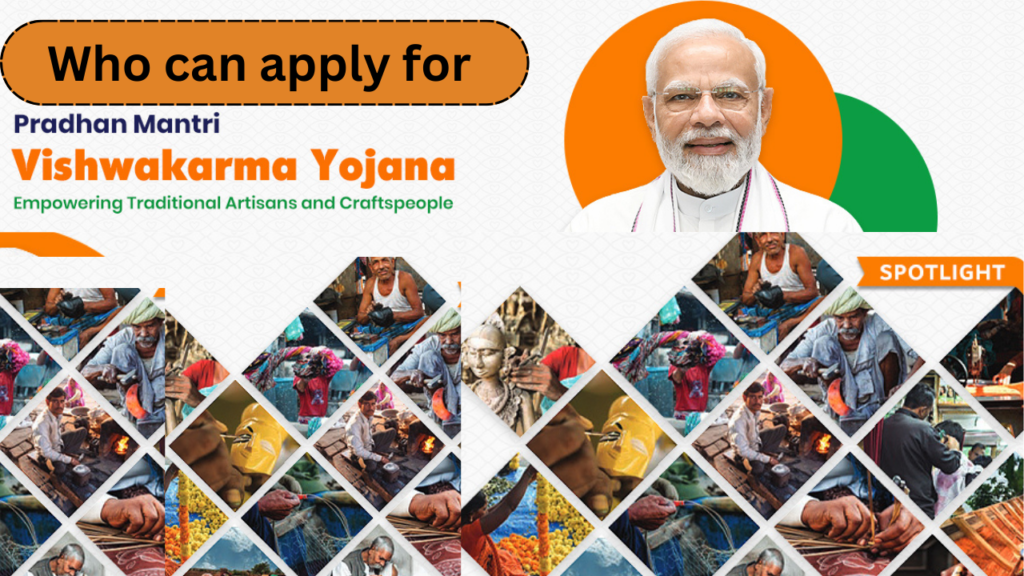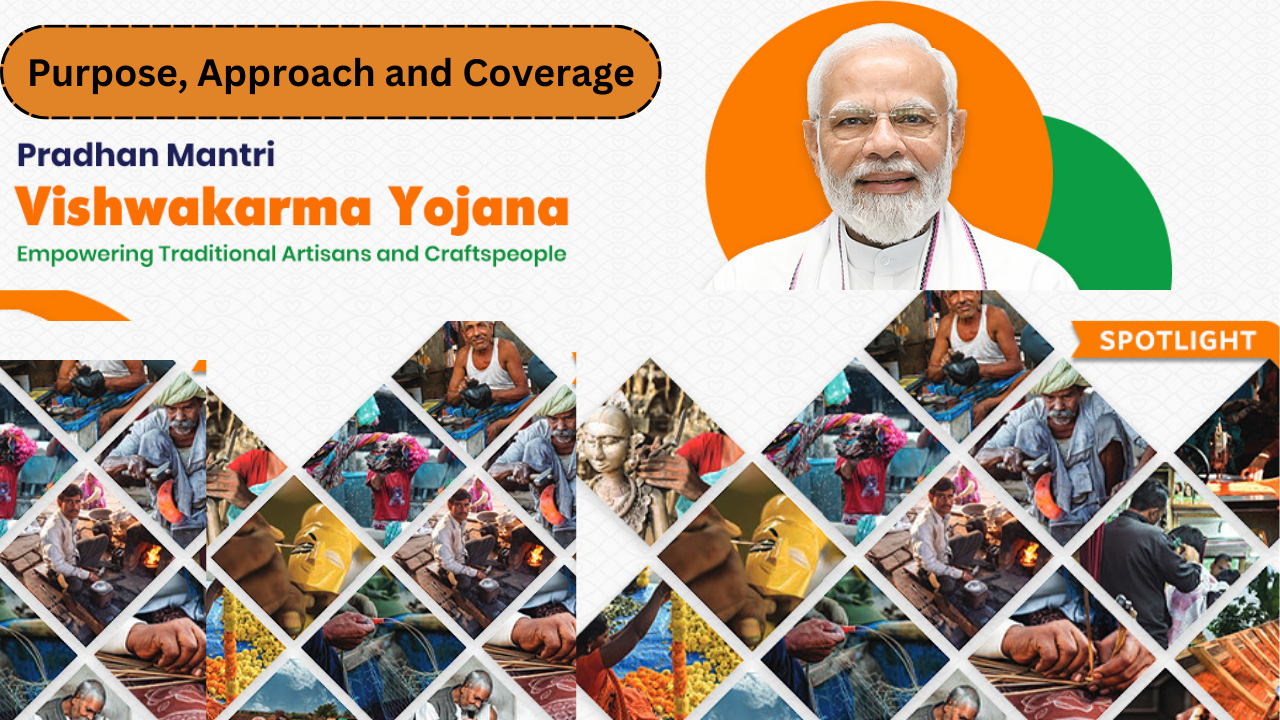The purpose of PM vishwakarma scheme is as under

- To recognize and support artisans and craftspeople as skilled workers (Vishwakarma) so they can access various benefits under the Scheme.
- To enhance their skills through training.
- To provide them with better tools to improve their productivity and the quality of their work.
- To make it easier for them to get loans without the need for collateral and reduce the cost of borrowing through interest subsidies.
- To encourage digital transactions and empower artisans through incentives.
- To offer a platform for branding and connecting with markets, helping them grow.
Approach of PM Vishwakarma
- This Scheme is designed to benefit self-employed artisans and those looking to start small-scale businesses. It aims to preserve traditional skills, cultural practices, and the guru-shishya tradition while giving these artisans recognition.
- The Scheme provides comprehensive support to artisans in their respective trades.
- It focuses on empowering women and marginalized groups like Scheduled Castes, Scheduled Tribes, OBCs, people with disabilities, transgenders, residents of North Eastern states, island territories, and hilly areas.
- The Scheme will roll out in both rural and urban areas, with a phased approach in districts.
- The Scheme will also promote awareness about insurance, pension, and health schemes. Efforts will be made to ensure beneficiaries can access social security benefits like life and accident insurance, pension, and other government schemes.
- The implementation of the Scheme will involve collaboration at various levels.
Trades Covered under PM Vishwakarma
Who can apply for pmvishwakarma scheme
- Initially, the Scheme will cover traditional trades listed in Table 1. It aims to help artisans in these trades scale up their operations, upgrade their tools and businesses, and transition into the formal economy, contributing to the nation’s growth.
| SNo. | Trade | Description |
|---|---|---|
| 1 | Boat Maker | Self-employed artisans and craftspeople who work with |
| (Wooden Boat Craftsman) | their hands and tools to make, assemble, alter, or | |
| repair wooden boats in the unorganized sector. | ||
| —— | ————————— | ———————————————————- |
| 2 | Armourer | Self-employed artisans and craftspeople who manufacture, |
| (Arms Manufacturer) | repair or service various types of arms like swords, | |
| shields, knives, helmets, etc. using hands and | ||
| traditional tools employed in the unorganized sector. | ||
| —— | ————————— | ———————————————————- |
| 3 | Iron/Metal Based/ | Self-employed artisans and craftspeople, including |
| Stone Based Craftsman | blacksmiths, coppersmiths, and bronzesmiths, who work | |
| with their hands and tools to forge metals like iron, | ||
| copper, brass, or bronze to get the required shape | ||
| and size by heating, bending, hammering, etc. to | ||
| create products in the unorganized sector. | ||
| —— | ————————— | ———————————————————- |
| 4 | Blacksmith | Self-employed artisans and craftspeople who work with |
| (Lohar) | their hands and tools to forge metals like iron to get | |
| the required shape and size by heating, bending, | ||
| hammering, etc. to create products in the unorganized | ||
| sector. | ||
| —— | ————————— | ———————————————————- |
| 5 | Carpenter | Self-employed artisans and craftspeople who work with |
| (Suthar/Badhai) | their hands and tools to make/assemble wooden products | |
| or alter/repair wooden fixtures, mostly engaged in | ||
| traditional/unorganized sector. | ||
| —— | ————————— | ———————————————————- |
| 6 | Sculptor | Self-employed artisans and craftspeople also known as |
| (Moortikar, Stone Carver) | Shilpis or Moortikars who work with their hands and | |
| Stone Breaker | tools to carve, break or shape stones into | |
| three-dimensional artworks in the unorganized sector. | ||
| —— | ————————— | ———————————————————- |
| 7 | Gold/Silver Based | Self-employed goldsmiths/sonar/swarnakars, silversmiths |
| Craftsman | are artisans and craftspeople who work with their | |
| hands and tools to create and design intricate | ||
| jewellery and ornamental pieces with gold and other | ||
| precious metals in the unorganized sector. | ||
| —— | ————————— | ———————————————————- |
| 8 | Clay Based | Self-employed artisans and craftspeople who work with |
| Potter (Kumhaar) | their hands and tools to create pottery articles by | |
| moulding clay on a wheel and baking them in a kiln | ||
| using traditional methods in the unorganized sector. | ||
| —— | ————————— | ———————————————————- |
| 9 | Hammer and Tool Kit Maker | Self-employed artisans and craftspeople found in small |
| roadside stalls or travelling in streets who use hands | ||
| and traditional tools like cutter, hammer, needle, | ||
| threads, etc. in the unorganized sector to assemble, | ||
| install and repair locks. | ||
| —— | ————————— | ———————————————————- |
| 10 | Basket/Mat/Broom Maker/ | Basket Makers are self-employed artisans and |
| Coir Weaver | craftspeople who weave pliable materials to make | |
| different types of baskets in the unorganized sector. | ||
| —— | ————————— | ———————————————————- |
| 11 | Masons (Rajmistri) | Artisans and craftspeople who work with their hands |
| and tools to perform construction work using brick, | ||
| block, plastering, cement, waterproofing, etc. in the | ||
| unorganized sector. These artisans are also known as | ||
| Rajmistri. | ||
| —— | ————————— | ———————————————————- |
| 12 | Mat Makers/Coir Weavers | Self-employed artisans and craftspeople who weave coir |
| and bamboo materials to make items such as Baskets, | ||
| Mats, etc. | ||
| —— | ————————— | ———————————————————- |
| 13 | Broom Makers | Self-employed artisans and craftspeople who process |
| bristles collected from various grass or plants such | ||
| as coconut to make brooms using tools such as wooden | ||
| handle, scissors, knife, etc. | ||
| —— | ————————— | ———————————————————- |
| 14 | Cobbler | Self-employed artisans who work with their hands to |
| (Charmakar/Shoesmith) | manufacture, repair, restore, and modify footwear. | |
| —— | ————————— | ———————————————————- |
| 15 | Doll & Toy Maker | Self-employed artisans and craftspeople who work with |
| (Traditional) | their hands and tools to make Dolls and Toys using | |
| materials such as wool, threads, cotton, wood, etc. | ||
| —— | ————————— | ———————————————————- |
| 16 | Barber (Naai) | Self-employed artisans and craftspeople who work with |
| their hands using scissors, blades, combs, shaving | ||
| creams, etc. to provide grooming services, primarily | ||
| hair cutting, shaving, etc. | ||
| —— | ————————— | ———————————————————- |
| 17 | Garland Maker (Malakaar) | Self-employed artisans who create decorative garlands |
| made of flowers, leaves, or other materials for use | ||
| at rituals, cultural, or ceremonial occasions. They | ||
| arrange and string together these elements, often | ||
| incorporating different colors and textures, to | ||
| produce beautiful and fragrant adornments. | ||
| —— | ————————— | ———————————————————- |
| 18 | Washerman (Dhobi) | Self-employed artisans and craftspeople who work with |
| their hands to provide services such |
For details kindly visit https://pmvishwakarma.gov.in/
Also read PM Vishwakarma Scheme 2023

1 thought on “PM Vishwakarma: purpose, approach and coverage”